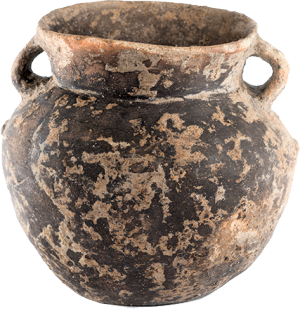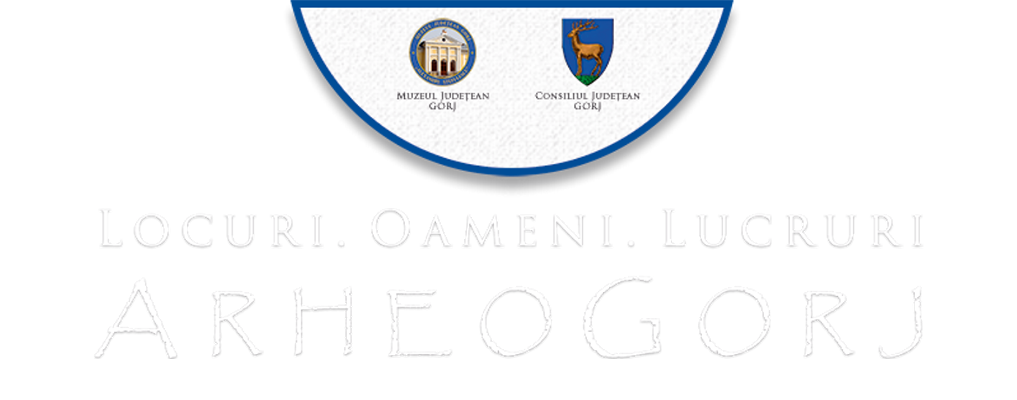
The archaeological research performed at Romanești, in the place known as “Lunca Romanești“, unveiled historical remains dated during four distinct habitation stages. The settlement of the human communities in the area was determined by the immediate proximity of the Amaradia Valley, a proximity transposed in fertile fields and rich fishing and hunting grounds.
The oldest stage can be attributed to the Coțofeni culture of the Early Bronze Age and consists of several pits, not very numerous, the archaeological inventory of which was constituted mainly of fragments of pottery.
 The second habitation stage is also poorly represented, dating from the middle of the Bronze Age and belonging to the early stages of the Verbicioara culture. This historical period is represented here by a series of domestic waste filled pits. Nevertheless, the shape of some pits suggests an initial destination for supply storage.
The second habitation stage is also poorly represented, dating from the middle of the Bronze Age and belonging to the early stages of the Verbicioara culture. This historical period is represented here by a series of domestic waste filled pits. Nevertheless, the shape of some pits suggests an initial destination for supply storage.
The most important habitation component in this site belongs to the Getic culture. The settlement, with its more than 200 complexes investigated here, among which are numbered households, supply pits and offerings bearing pits, becomes one of the largest studied so far in Oltenia.
Of particular importance are the glass paste jewellery pieces, attesting links to the Intra-Carpathian space and, least but not last, amphora fragments and the handle of a bronze cup. The latter reveals the existence of some trade relations at great distance, a result of the economic power and the refined taste of the local nobility. The Getic habitation dating covers the 2nd and 1st century B.C, some findings suggesting even an earlier debut, from the end of the 3rd century B.C.
The last stage, poorly represented among our findings, belongs to a habitation from the age of migrations. The findings are represented by two compact groups of complexes, located both on the Western limit and in the Eastern extremity of the site, at a quite large distance among them.
Regarding the archaeological complexes, a hut is noticed here, with a small oven situated on the north-western side, alongside other remains from constructions of irregular shape, some of them being quite large, their purpose remaining imprecise. In spite of the low number of items and of archaeological complexes, the importance of this habitation is undeniable. Its contribution fills in the picture of the 6th and 7th century AD findings, being the only settlement of the kind studied in the North-Western Oltenia.
Exhibit 9
Archaeological materials characteristic to Coțofeni and Verbicioara culture.
- Miniature vessel; Coțofeni culture
- Pitcher (?); Coțofeni culture
- Cup; Verbicioara culture
- Cup; Verbicioara culture
- Cup; Verbicioara culture
- Cup; Verbicioara culture
- Jar vessel; Coțofeni culture
- “Clepsydra” vessel; Verbicioara culture
- Bowl; Verbicioara culture
- Fragmented pot; Coțofeni culture
Exhibit 10
Archaeological materials characteristic to Getic civilisation.
- Bracelet fragment; Getic culture
- Spindle whorl; Getic culture
- Amphora fragment; Getic culture
- Lid fragment; Getic culture
- Kantharos fragment; Getic culture
- Kantharos fragment; Getic culture
- Cup; Getic culture
- Bowl fragment; Getic culture
- Cup lamp; Getic culture
- Jar vessel; Getic culture
- Strainer fragment; Getic culture
- Bowl with leg, fragment; Getic culture
- Jug; Getic culture
Exhibit 11
Archaeological materials characteristic to Getic civilisation and Slavs population.
- Spindle whorl; Ipotești-Cândești culture (sec. VI p.Chr.)
- Vessel fragment; Ipotești-Cândești culture (sec. VI p.Chr.)
- Salver fragments; Ipotești-Cândești culture (sec. VI p.Chr.)
- Miniature vessel; Ipotești-Cândești culture (sec. VI p.Chr.)
- Jar vessels fragments; Ipotești-Cândești culture (sec. VI p.Chr.)
- Vessel with animal representations; Getic culture
- Jar vessel; Getic culture

